Israel vs Iran: GBU-57A/B MOP Bunker Buster or Bunker Busted [i]
Israel (and the US) Against Iranian Underground Facilities
The GBU-57A/B Massive Ordnance Penetrator (MOP), developed by the United States, is one of the most powerful conventional weapons ever built — a non-nuclear "bunker buster" designed to destroy deeply buried and hardened underground facilities.
This article provides a technical breakdown of the MOP’s capabilities and limitations when targeting Iranian underground military sites, including nuclear facilities and command centers. We’ll explore how deep these bunkers are, what they're made of, and whether the MOP can actually destroy them.
The historical background of the bunker busters’ use in the modern post-WWII conflicts includes the Gulf War & Iraq (1991–2003). Despite heavy use of bunker busters, many Iraqi bunkers survived due to their depth and construction. Some attacks resulted in civilian casualties, raising ethical concerns about the potential for collateral damage.
In Lebanon, bunker busters had mixed success due to complex geology and extensive tunneling.
To date, the MOP has never been used in combat. Simulated tests suggest potential effectiveness, but real-world conditions — weather, terrain, enemy countermeasures — remain unknown.
Technical characteristics:
Weight : ~30,000 lbs (~13,600 kg)
Length: ~20.5 ft (6.2 m)
Diameter: 31.5 in (0.8 m)
Warhead: ~5,342 lb (2,423 kg)
Explosive weight:
AFX-757: 4,590 pounds (2,082 kg)
PBXN-114: 752 pounds (341 kg)
Penetration Capability1: Up to 200+ feet of reinforced concrete or 1,000 feet of earth (under ideal conditions)
Guidance System: GPS/INS for precision targeting
Delivery Platform: B-2 Spirit stealth bomber
Mechanics, Effects, and Structural Impact of Massive Munitions
This section explores the penetration mechanics, structural effects, and resulting damage caused by high-mass, high-velocity penetrators impacting reinforced concrete and rock media, supported by simplified diagrams and physics-based analysis.
The ability to strike deeply buried underground bunkers has long been a critical concern in strategic military operations. These hardened facilities are designed to withstand conventional attacks and often house command centers, weapons storage, or critical infrastructure. The use of massive penetrator munitions —such as the GBU-57A/B Massive Ordnance Penetrator (MOP), Russian FAB-3000 class bombs, or specialized warheads carried by ballistic missiles like the Kinzhal and mysterious Oreshnik—represents some of the most effective methods for defeating such targets.
More about attacking underground structures can be found here:
Attacking the Underground Objects [i]
In recent days (especially end of September and beginning of October 2023) it became obvious that Russia is using more and more heavy bombs (designated as FAB-500 and FAB-1500) equipped with guidance…
Oreshnik Against Zelensky's Bunker [i]
This article is about the damaging effects of ammunition with a particular analysis of what the Oreshnik warhead can do to a target. The whole subject of hypersonic impact on the ground is highly tec…
The MOP is a massive, precision-guided bomb specifically designed to strike hardened underground targets.
Unlike traditional bombs, the MOP uses its mass and speed to punch through layers of rock and concrete before detonating deep underground. Its explosion creates intense shock waves and overpressure, which can collapse tunnels and chambers even if the warhead doesn’t directly hit them.
Mechanics of Penetration
When a massive penetrator strikes a target at high velocity, it undergoes a complex sequence of interactions with the material it impacts. The process can be broken down into three major phases:
Initial Contact and Cratering
At the moment of impact, the projectile's kinetic energy is transferred to the target surface, causing localized stress far beyond the yield strength of the material. This results in crater formation and the initial displacement of material along radial and lateral directions.
Velocity: > 250 m/s typical for large gravity bombs; up to 1,800 m/s for hypersonic systems.
Stress Waves: A shock wave propagates through the target medium, initiating spallation and fracturing.
Material Response: Concrete behaves like a brittle solid under high strain rates, while soil and rock may exhibit both ductile and brittle characteristics depending on composition and compaction.
Tunneling Phase
As the penetrator continues forward, it "tunnels" through the medium. Resistance is primarily due to frictional drag and plastic deformation of the surrounding material. The shape and mass of the penetrator, as well as its angle of attack, significantly influence this phase.
Terminal Phase – Deceleration and Explosion
Eventually, the penetrator decelerates due to cumulative resistance forces. At this point, the embedded explosive charge detonates, transferring energy directly into the surrounding structure. This phase is crucial for maximizing damage to internal chambers.
Buried Explosions: Generate radial cracks, conical fractures, and cavity expansion, leading to the collapse of tunnels and chambers.
Shock Wave Propagation: In multi-layered structures, reflections and refractions of the blast wave can amplify damage.
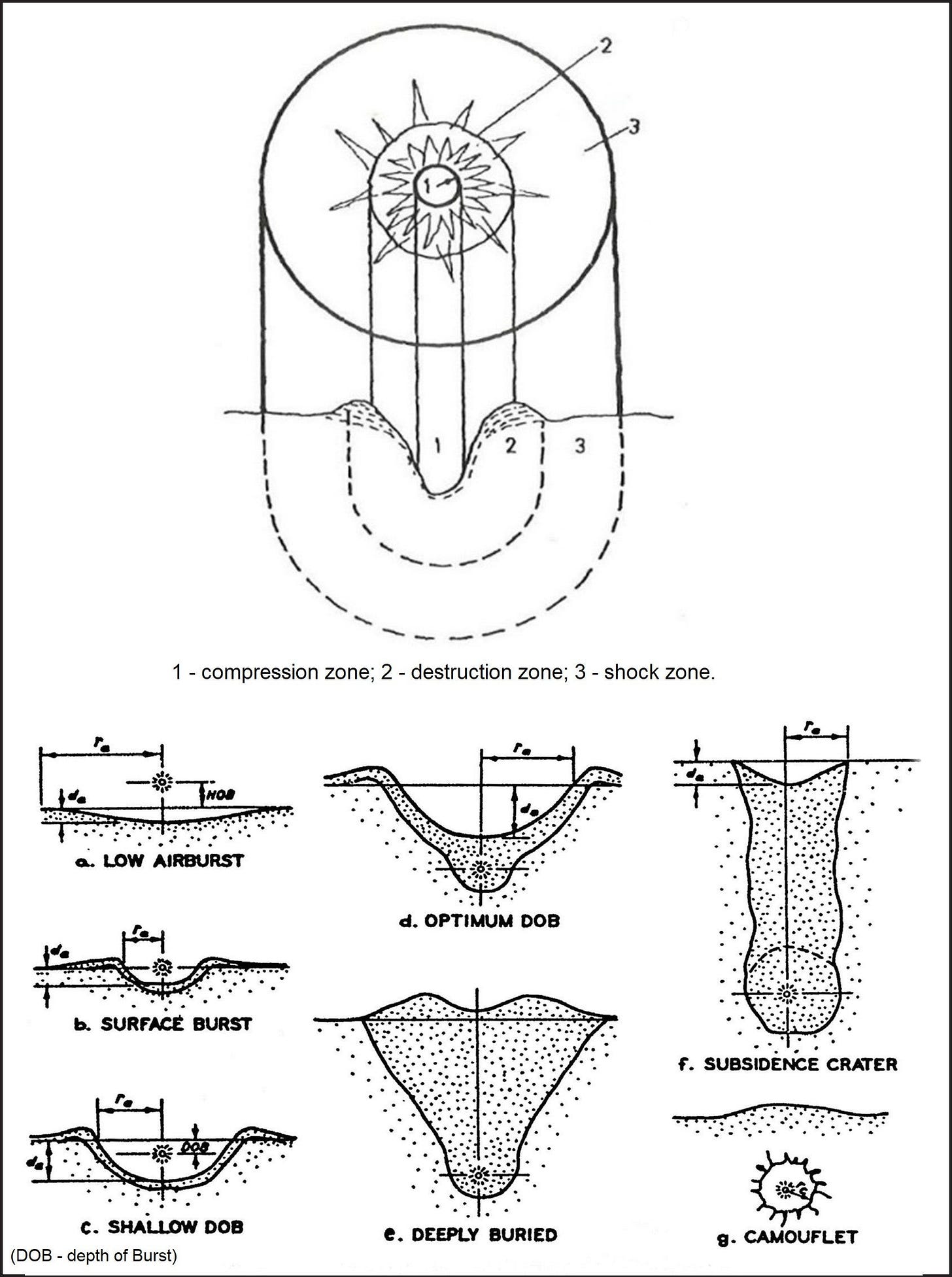
Impact Velocities
Let’s now consider one of the scenarios: To calculate the maximum speed of the GBU-57A/B MOP dropped from 12,000 meters altitude with a forward launch speed of 800 km/h, we need to consider two things. The first is without air resistance (which sounds very good for marketing purposes):
Ignoring Air Resistance (Free Fall + Forward Motion)
If we ignore air resistance, the bomb's vertical speed from free fall is ≈485m/s
Resulting total speed (vector sum of horizontal + vertical) ≈533.6m/s
Maximum speed without air drag: ~534 m/s (~1,922 km/h)
If dropped from 15.000 m, it can reach 600 m/s, but this is only a theoretical estimate.
Realistic Approach - With Air Resistance
The bomb encounters aerodynamic drag, especially at transonic and supersonic speeds. MOP is designed to penetrate, not glide efficiently. Empirical modeling or simulations (e.g., CFD or physics solvers) suggest a terminal velocity in the range of 300–350 m/s, depending on altitude and air density.
At sea level: Terminal velocity ~ 280–310 m/s
From high altitude: It could briefly exceed 350 m/s as drag increases gradually with denser air.
Realistic max velocity with drag ≈ 330–380 m/s, with a horizontal component adding slightly to this.
At such velocities, the kinetic energy alone allows the bomb to penetrate deep into reinforced structures before detonation. Many bunker busters also feature delayed fuzes, ensuring they explode after penetrating the target.
Iran’s Underground Facilities: A Strategic Overview
Iran has invested heavily in deeply buried infrastructure, designed to survive airstrikes and sanctions. These include:
Missile production and storage sites
Uranium enrichment plants
Command and control centers
Air defense systems
Leadership shelters
Some of the most well-known suspected or confirmed underground facilities include:
Fordow Facility (near Qom) - Buried inside a mountain; previously used for uranium enrichment
Parchin Military Complex - Suspected site of past nuclear weapons research
Isfahan Uranium Conversion Facility - Converts raw uranium into forms usable in centrifuges
IRGC Command Centers - Deeply embedded leadership shelters
These installations are typically constructed with:
Thick reinforced concrete walls
Earth berms (layers of dirt that absorb explosions)
Multi-level tunneling networks
Redundant access points and escape routes
Many of these sites are located hundreds of feet and hundreds of meters underground, making them extremely difficult to target effectively. According to some estimates, in addition to the above-mentioned, Iran has over 70 other underground facilities.
Iranians used Ultra-High-Performance Concrete (UHPC)2 in many of their structures. UHPC is a cutting-edge material that significantly surpasses traditional concrete in terms of strength, durability, and impact resistance. Originally developed for civilian infrastructure in seismic zones, UHPC has become a key material in military fortifications due to its exceptional compressive and tensile strength.
UHPC is a fine-grained, fiber-reinforced composite, often including quartz sand for high hardness and fine particle size for dense packing; Portland cement combined with fumed silica for enhanced strength and reduced porosity; steel fibers to improve ductility, crack resistance, and energy absorption; and superplasticizers to maintain workability with low water-to-cement ratios (~0.2)
There are several reasons why the use of this material, combined with the natural environment, can resist GBU-57A/B:
The first one is characterized by extreme toughness, exhibiting a compressive strength of over 280 MPa. This is 4–5× harder than conventional concrete. It significantly slows penetration and increases the chance of deflection or ricochet for the penetrator.
The second reason is that the steel fibers contribute to tensile ductility, preventing catastrophic failure by bridging cracks.
The third reason is energy dissipation. Under impact, fibers and matrix absorb shock more evenly, preventing spalling and plug formation.
The fourth reason is layered integration. UHPC is often poured in multi-layer configurations, backed by traditional concrete or steel for hybrid defense.
Can GBU-57A/B MOP Destroy Iranian Bunkers?
Let’s look at three key factors that determine if the MOP can successfully destroy hardened targets.
Structural Response and Damage Mechanisms
Underground bunkers are typically constructed using reinforced concrete, steel-reinforced earth, or excavated mountain complexes. Their survivability depends on:
Depth of Burial (DOB)
Reinforcement Type
Redundant Layouts
Blast-Resistant Design
Upon penetration and detonation, several key structural failure modes occur:
Spalling
High-stress waves reflect from free surfaces inside the bunker, creating spalls —fragments that break off the inner walls. Spalling can cause lethal injuries and equipment damage even if the outer shell remains intact.
Cratering and Breaching
The initial explosion creates a central crater, removing layers of protective material and exposing deeper structures. If the charge is sufficiently powerful, it can breach into adjacent chambers.
Progressive Collapse
Repeated shocks or multiple penetrations can lead to progressive collapse, especially in non-isolated chamber designs. Support pillars and ceiling slabs may fail sequentially.
Air-Blast Overpressure
Even when the penetrator does not fully reach the main chamber, the transmitted air-blast pressure through connecting shafts and ventilation systems can incapacitate personnel and destroy sensitive electronics.
Depth and Construction Materials
Take Fordow as an example:
Located 75–100 meters (250–330 feet) underground within a mountain. This is an estimate based on publicly available information. The key Iranian bunkers may be much deeper.
Estimated reinforced concrete thickness: up to 7 meters of high-performance concrete.
Possibly shielded by additional layers of earth and rock.
Even the MOP, with its immense power, may not fully penetrate such a structure, especially if it strikes at an angle or misses the weakest point.
Newer versions of the MOP may have enhanced software and better guidance, but real-world combat performance remains untested.
Effectiveness of Detonation
Even if the MOP reaches its intended depth, destruction isn't guaranteed:
The explosion must generate enough overpressure to collapse tunnels and damage internal structures.
Multiple strikes targeting the exact impact point may be needed, especially for multi-chambered complexes.
Seismic modeling suggests that unless the warhead detonates very close to critical areas (like centrifuge halls), the facility could remain partially functional.
Targeting Challenges
Hitting the right spot is crucial:
Accurate intelligence is required to locate air shafts, ventilation ducts, or weak points.
Iran is likely to employ decoys, false entrances, and mobile assets to mislead attackers.
Counterforce measures, such as emergency sealing of chambers or evacuating personnel, can mitigate the impact of an attack.
Without precise information and timing, even the most powerful weapon may miss its mark.
Supporting Tools and Tactics
While the MOP is the most powerful option, it works best when combined with other tools, which may help “soften” the targets. These tools are GBU-28/B smaller bunker busters (~5,000 lb), effective against ~10–20 ft of concrete; the BLU-109/B, which can penetrate about 6 ft of concrete and is useful for follow-up strikes; JSOW/JDAM, precision-guided bombs for secondary targets like entry points; and Cyber & Electronic Warfare to disrupt communications, disable sensors, or trigger false alarms.
Together, these tools form part of a comprehensive strike package designed to maximize damage and minimize risk.
What does this mean in practice? The USAF may launch 4-6 B-2s flying from Diego Garcia, each carrying 2 MOPs. As the known number of all MOPs produced is 20-24, one attack may consume half of that. This strike will be supported by several SEAD groups (USAF and IAF), as well as 3-4 strike groups with smaller bunker-buster capabilities in an auxiliary role.
Conclusion
The main question is, can MOP destroy the key Iranian underground facilities?
The MOP has the technical capability to destroy some of Iran's deeply buried targets, particularly those with moderate reinforcement and accessible weak points; however, against heavily fortified, multi-layered nuclear sites like Fordow, a single MOP strike is highly unlikely to guarantee destruction for several key reasons.
Multiple strikes, accurate intelligence, and post-strike verification would be necessary to ensure effective results. Even then, underground facilities and critical components, such as blueprints, enriched material, or personnel, could survive. Iranians are aware of what is coming, and they have taken all necessary precautionary measures to counter the threat. It is plausible that Iranians dug much deeper than what is presumed.
At the strategic level, using the MOP would likely provoke escalation, including retaliatory strikes by Iran or its proxies. It could also cause collateral damage, regional instability, and international backlash.
Therefore, while the MOP offers a credible military option, it is not a guaranteed solution.
The Massive Ordnance Penetrator represents the pinnacle of current bunker-busting technology — a strategic tool capable of striking deeply buried threats.
However, against Iran’s sophisticated underground infrastructure, its success depends on a combination of technology, intelligence, and tactics.
For maximum impact, the MOP should be part of a broader strategy that includes:
Advanced reconnaissance and surveillance
Precision delivery platforms
Follow-on kinetic and cyber effects
Post-strike verification and containment efforts
As warfare evolves, future technologies like hypersonic weapons, autonomous drones, and AI-based targeting systems may offer more reliable ways to neutralize deeply buried threats.
[i] Edited by Piquet (EditPiquet@gmail.com)
References
Ultra-high performance concrete: A review of its material properties and usage in shield tunnel segment Fangyuan Niu, Yuhang Liu, Fangchen Xue, Hao Sun, Tong Liu, Haijun He, Xuguang Kong, Yunteng Chen, Hongjian Liao, Elsevier
Rockets and Missiles Over Ukraine, Frontline Books
И. А. БАЛА ГАНСКИЙ: ДЕЙСТВИЕ СРЕДСТВ ПОРАЖЕНИЯ И БОЕПРИПАСОВ, НОВОСИБИРСК
I.V. Balagansky: Damaging Effects of Weapons and Ammunition, Willey
S. Jaramaz, Physics of Explosion.
Cratering by Explosion, Compendium
If you like the article (and many more articles regarding military subjects will come), you can buy me a coffee:
https://www.buymeacoffee.com/mmihajloviW
This is declared by the manufacturer and Pentagon officials. Information shall be taken with reserve.
Ultra-high performance concrete: A review of its material properties and usage in shield tunnel segment Fangyuan Niu, Yuhang Liu, Fangchen Xue, Hao Sun, Tong Liu, Haijun He, Xuguang Kong, Yunteng Chen, Hongjian Liao.

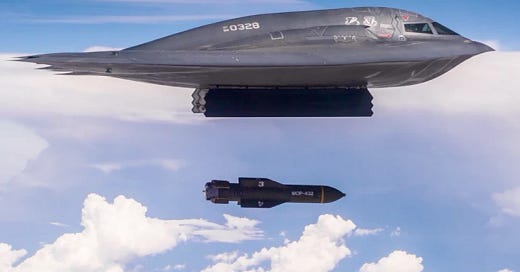



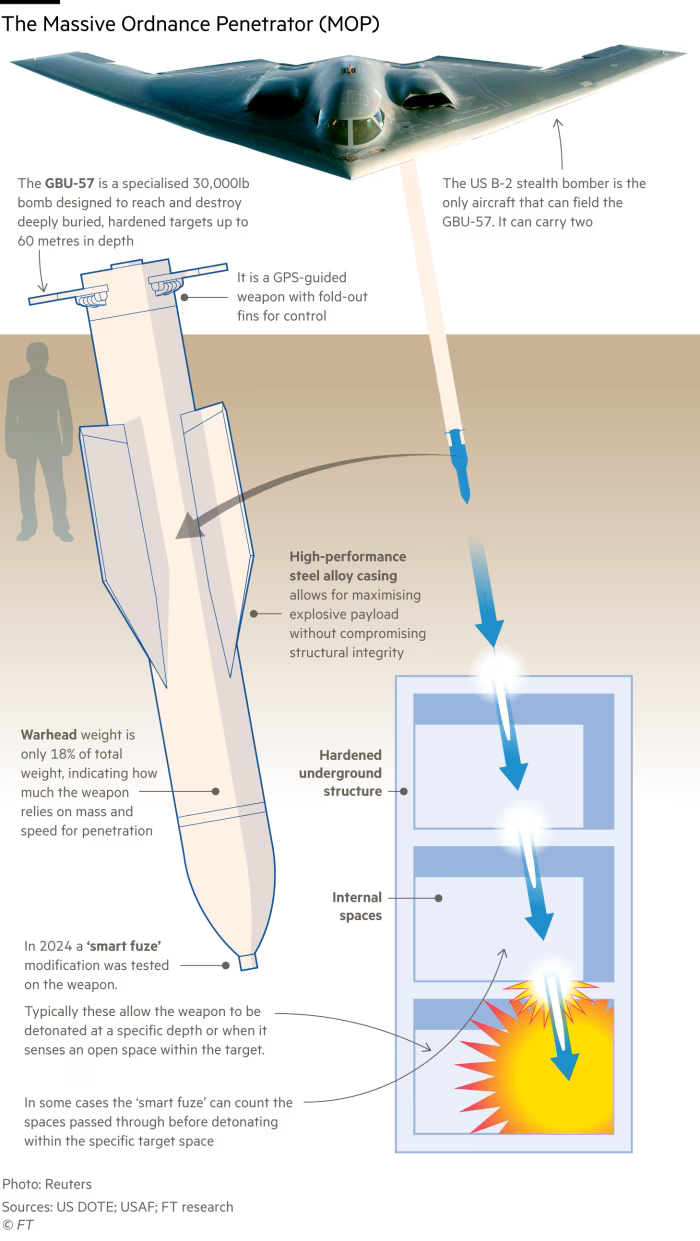
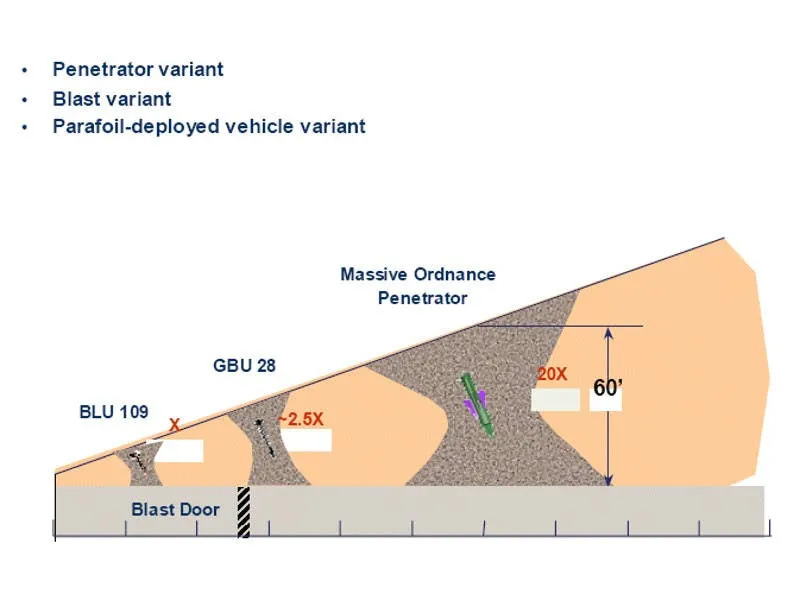
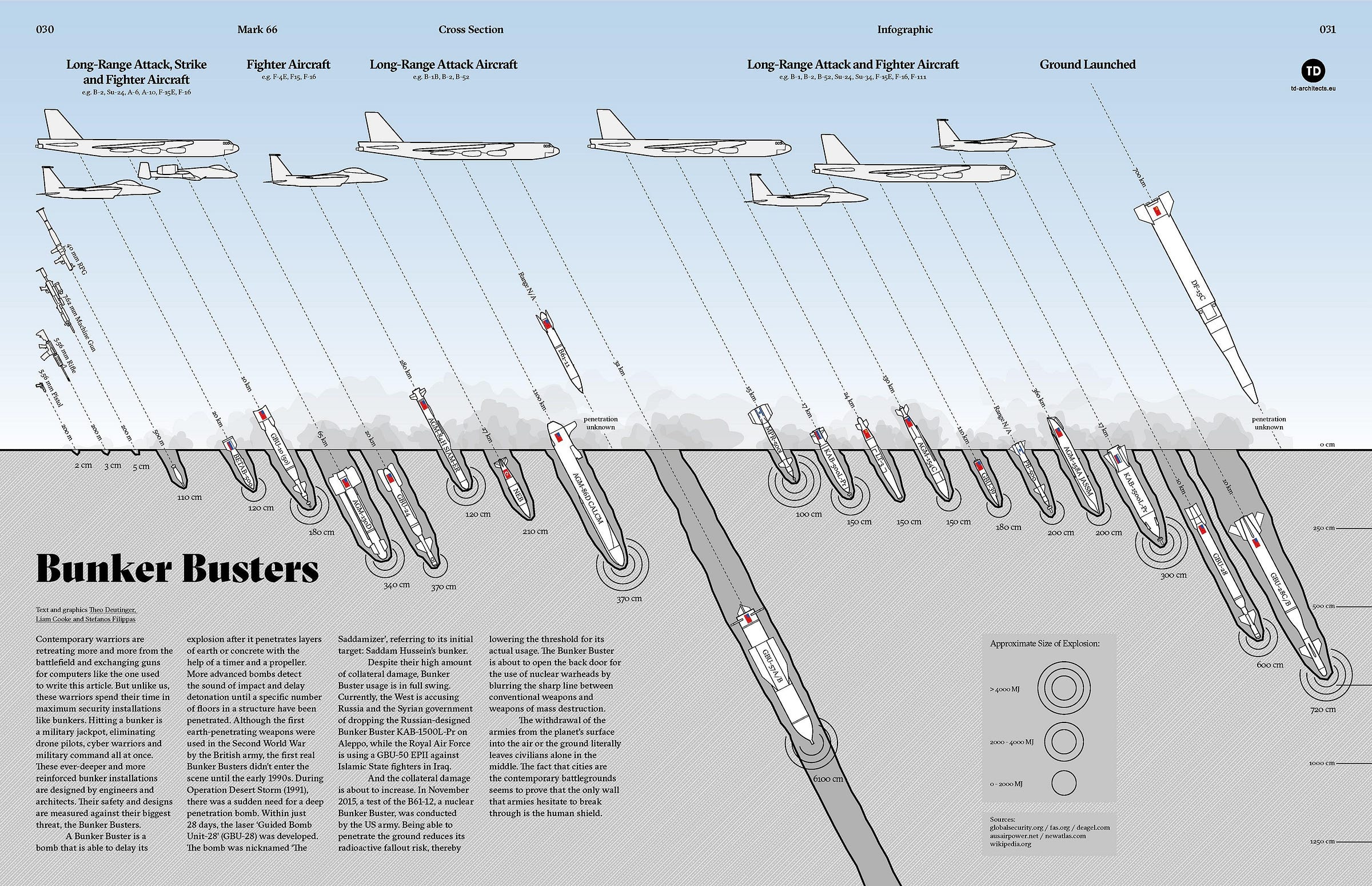
![Attacking the Underground Objects [i]](https://substackcdn.com/image/fetch/$s_!cS05!,w_280,h_280,c_fill,f_auto,q_auto:good,fl_progressive:steep,g_auto/https%3A%2F%2Fsubstack-post-media.s3.amazonaws.com%2Fpublic%2Fimages%2F4cc337e8-1fc5-4da4-848c-6968f74be521_1280x960.jpeg)
![Oreshnik Against Zelensky's Bunker [i]](https://substackcdn.com/image/fetch/$s_!aNnr!,w_280,h_280,c_fill,f_auto,q_auto:good,fl_progressive:steep,g_auto/https%3A%2F%2Fsubstack-post-media.s3.amazonaws.com%2Fpublic%2Fimages%2F8e57f64e-7356-4db7-b43b-958a9f940d22_701x575.jpeg)
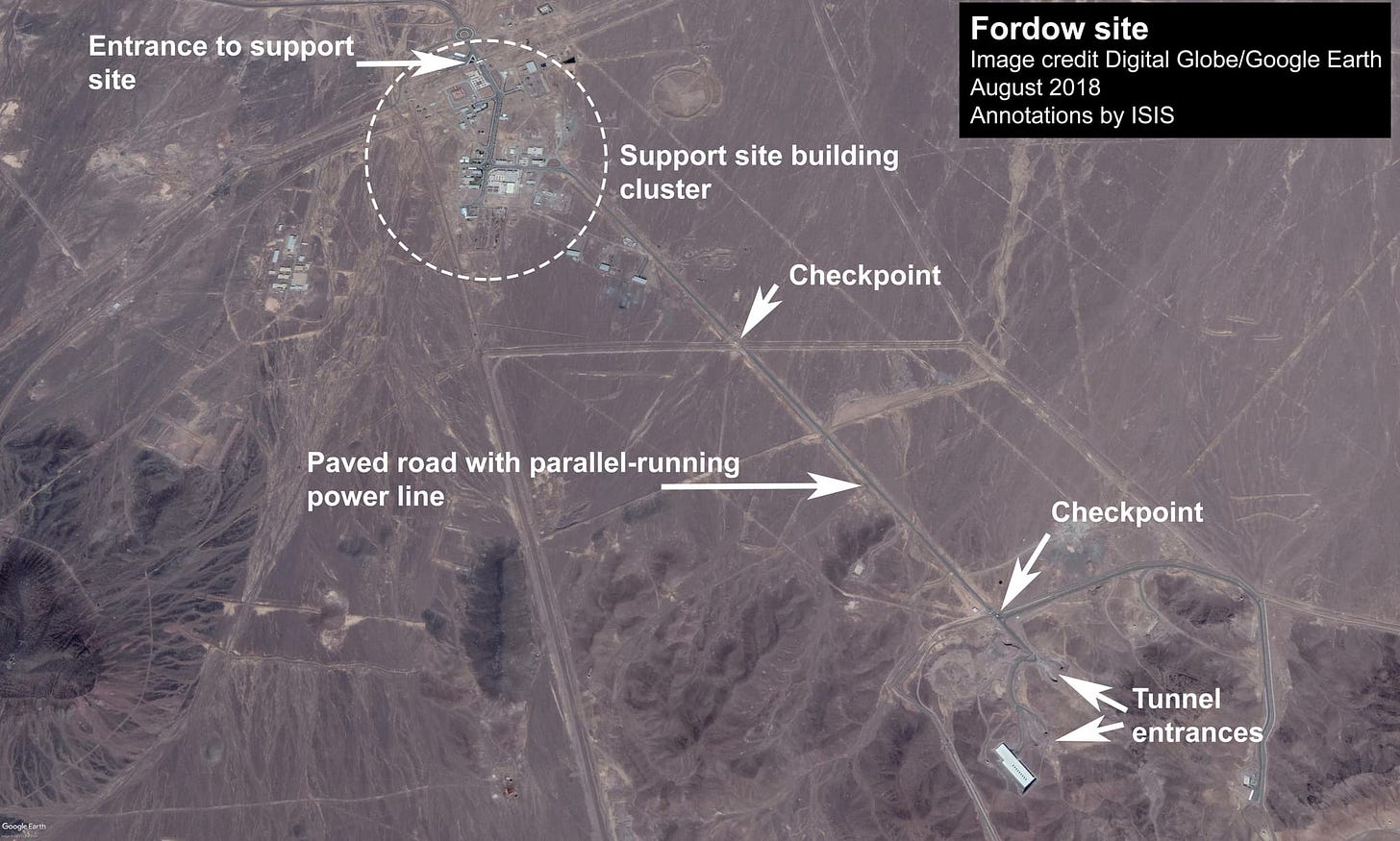
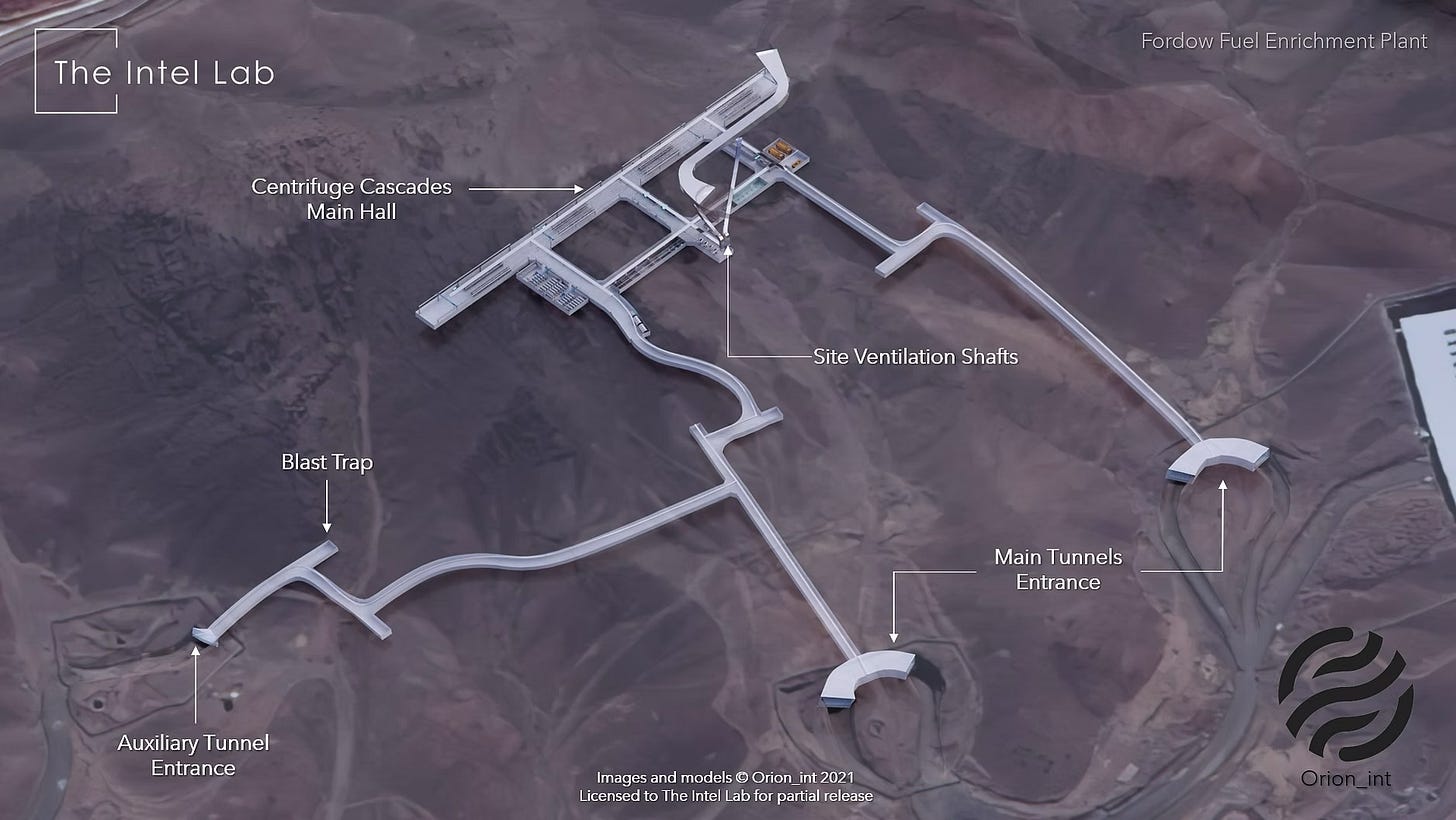
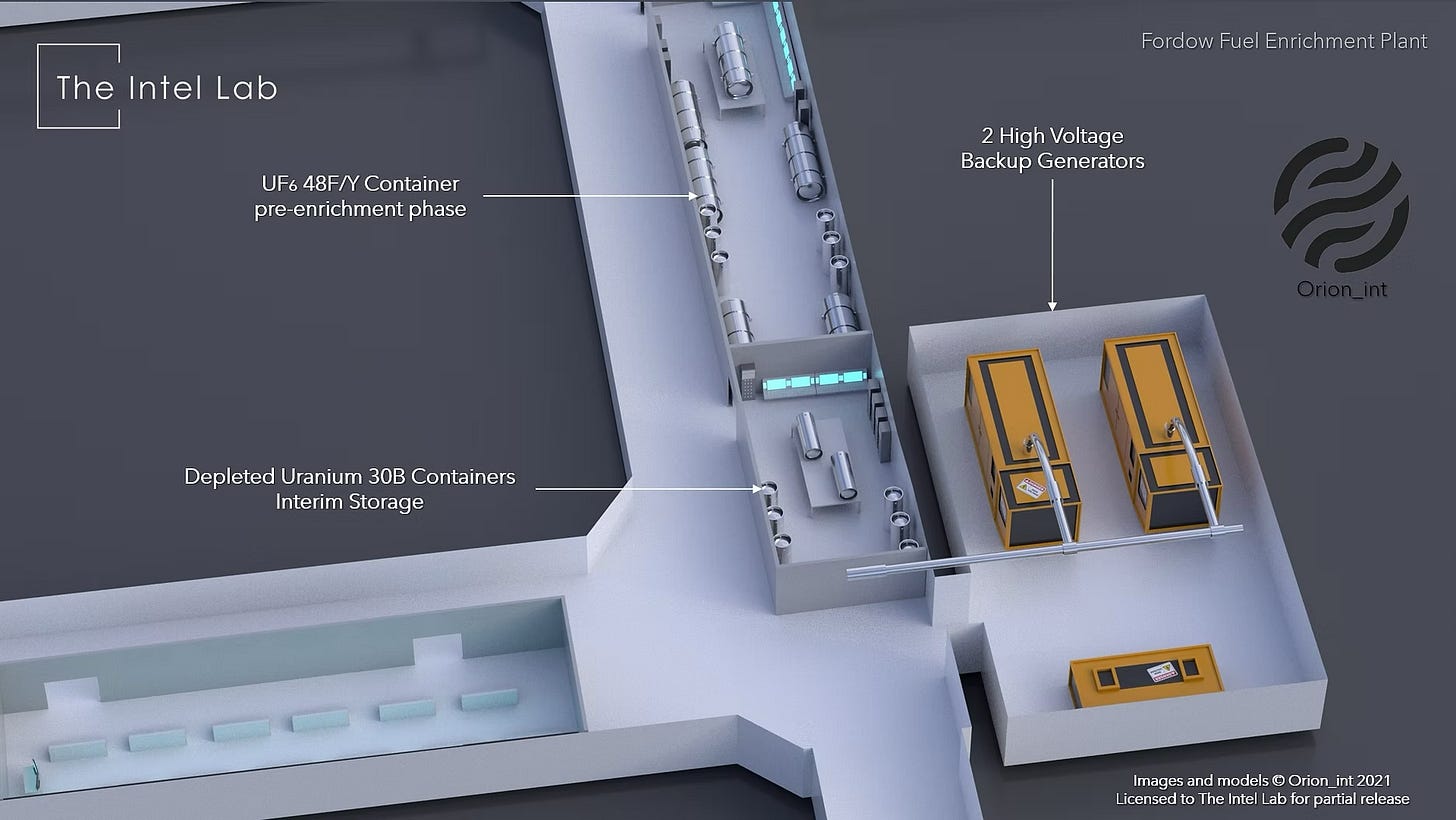

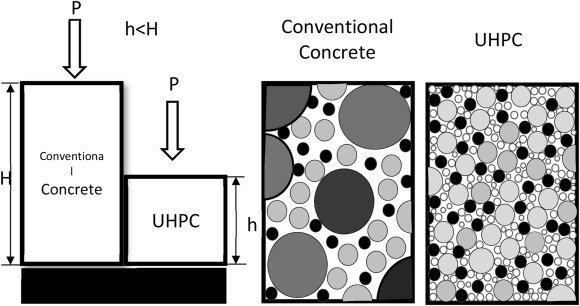
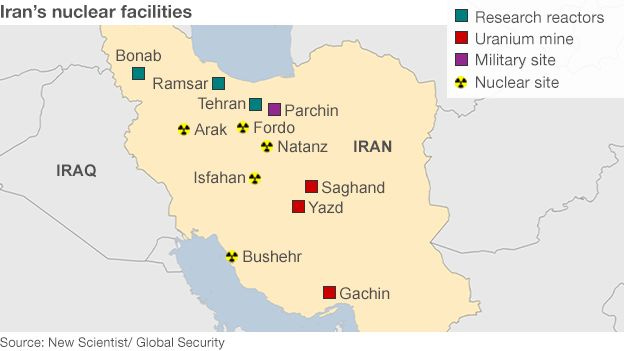
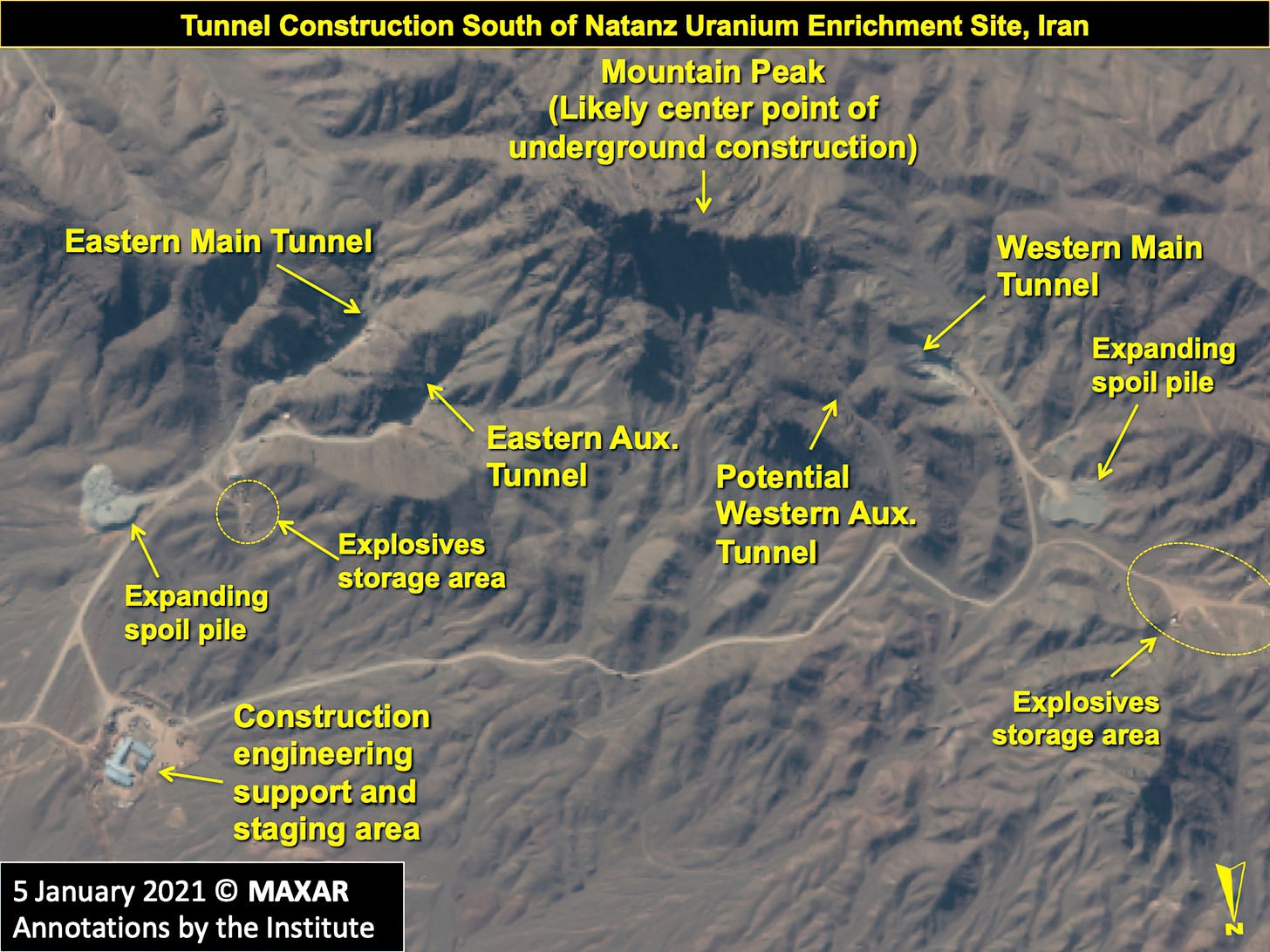
Hard to say, but if anyone knows, that would be the Mossad.
Good imformational article. The problem is that even if the multiple MOP attack works (as suggested by the author) and the facility is destroyed it will delay but not stop any Iranian nuclear programme. Iran did not have a military nuclear programme, but after the Israeli attack - and especially after any US attack - they will move heaven and earth to get a bomb. Netanyahu and Trump could be said to be the fathers of the Iranian bomb.